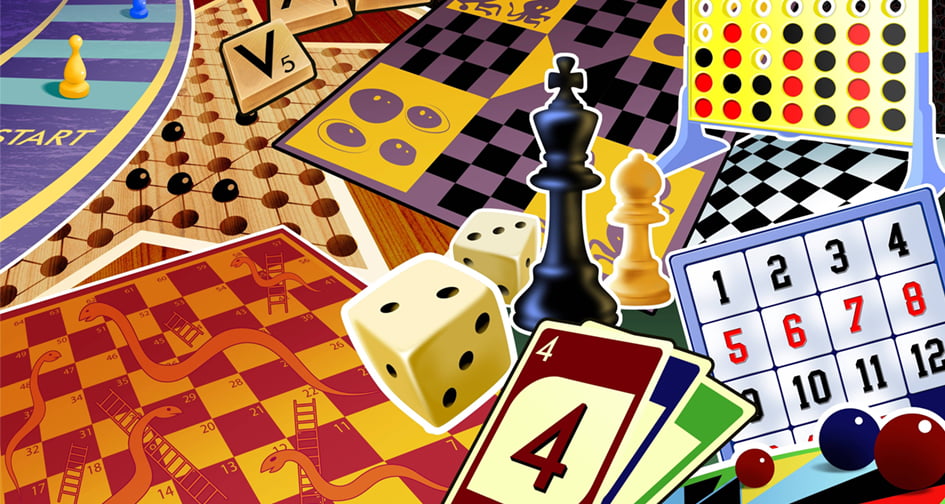A board game is a table top game that involves counters or pieces moved or placed on a pre-marked surface or board, according to a set of rules. Some of the games are purely based on strategy but some may contain an element of chance while some are purely chance based.
The creation of board games is as old as man. The earliest society was a hunter-gathering community. Although, the chunk of the day was spent looking for food; the men going to hunting and the women gathering food and cooking, however, it was during the time spent resting after these that the seeds of board games were sown. Several board games were created and these were modified down the ages, peaking in the 21st century, a development which made The Guardian, a UK based newspaper to declare that we are in the golden age of board games.

While we don’t have the privilege of knowing what kind of board games the ancients played because most of them left us with no surviving writings; the field of archaeology has however given us the chance to understand these. The first evidence of ancient board games is from a site known as the ‘Basur Hoyul’, a 5,000 year old burial mound in Southeast Turkey where archaeologists found nearly fifty small carved, painted stones considered to be the pieces of the oldest board games known to humanity. We now know how the game was played (it’s a race game and the British Museum historian, Irving Finkle spent years deciphering the rules). The game is now known as the royal game of Ur, although it was also open to commoners.
Archaeological evidence also suggests that ancient Egypt also was home to board games. The ancient queen Nefertari, wife of Ramsees II was depicted in her tomb playing a board game called Senet. The Egyptians also had another popular game called Mehen, however, we do not know which one is older. Senet was a race game; the board was divided into squares with counters. Players would throw stick rather than a dice. The game was played by the rich (and its paintings were common in the tomb of the rich people) and it was believed that the Egyptian gods Ra, Osiris and Thot protected those who will win the game.

Snakes and ladders were originated in India around 200BC as a game based on morality, where the progression up the board was to teach children about good and evil with climbing up ladders representing good and snakes sliding down representing evil. When the British occupied India, the game was brought into the west, where it quickly spread and was rebranded in the United States as “Chutes and ladders” by Milton Bradley.
The Mah Jong was another game developed in ancient china. It was a closely guarded secret of the Chinese aristocracy until it emerged popularly in the west in the 20th century. The current version of the game developed in the 1920s is a four-player game played with tiles on the board. Mahjong is usually played by 4 people in which tiles bearing various designs are drawn and discarded until one of the players have an entire hand of winning combinations.
The Romans also played a game called ‘Ludus Duodecim Scriptoeum’ translated as the game of the 12 markings. The emperor Claudius was an avid player of the game which is similar to the modern day Backgammon. Athough the game was popular in Rome, it was invented before the formation of Rome. Archaeologists have excavated the complete game of 12×10 squares with 24 glass pieces, 12 of white and 12 of blue. Due to limited sources however, reconstruction of the game’s rules has been difficult but it is generally accepted to be a game of military tactics. Game historians are still arguing about the mechanism of play in this archaic ancestor of strategic games. This is however the first known insurgence of military strategy in the gaming world. Based on a checkerboard, the game’s concept revolves around capturing your opponents’ pieces by using two of your own to corner them. Many believe that ‘Ludus Duodecim Scriptoeum’ was further refined to a simpler version of what we know now as Chess. The games appear to be using similar board, concept and pawn pieces. At the same time, no solid proof exists and some see both games as not related.
The medieval era also witnessed an upsurge in board games; a development which many analysts credits to the war like nature of the period which encouraged strategy games. Medieval strategy game like Alquerque can be considered an ancestor of draughts. Tablut was derived from the Viking game Hnefatafl and which was played in Northern Europe during medieval times.
Another game popularised in 18th Century France was Dominoes. While it is not precisely known where and when was the game invented, many historians agree that it was invented in China around 1100 AD. However, it wasn’t until the 18th century that the game got to the European continent. Its rapid growth in popularity the game has achieved when it was brought from Italy to France. The French even created a puzzle version of the game for which players had to place tiles over a pattern. Dominoes made its way over to Britain in the late 18th Century and then spread all over the world, finding particular popularity in Latin America.
Checkers (also known as Draughts) has some archaeological evidence that claims it was played as early as 3000 BC. At the same time, the board and pieces seem to significantly differ to what we know the modern checkers to be. Unfortunately, no description of the rules has been found, hence the correlation is only a speculation. An Egyptian game called Alquerque, however, is much similar to the checkers we know today and can be traced as far back as 1400 BC with the French deciding to finally place the game on a chess board around the year 1100 AD. The game and the current rules eventually found their way to England and America, and in 1847 the first checkers world championship was played. It was also one of the first games to go digital! Right before World War II, Alan Turing created a basic checkers game for the computer that required paper calculations to assist.
Along with variations of Chess, Checkers, and Backgammon, a number of other board games began to spring up around the European Renaissance like Dominoes. The printing press provided the next step in game evolution with the ability to add themes and subjects. One example of this is the game, Agon , known as the Game of The Hexagons. Agon is a strategy game played on a hexagonal 6×6×6 game board, and it was first played in France in the late eighteenth century with first official mention in 1872. The rules were simple, but the strategy could be quite involved, so they appealed to a wide variety of people and grew quickly in popularity. The idea behind the game is to protect a queen with six guards. Players begin at the edge of the board and take turns moving a piece one space in any direction. If a piece is caught between two enemies, it is captured. To win the game, your queen must make its way to the central space with the six guards in the adjacent spaces.
Another game, popular in France around the same time was called Conspirateurs . A two or four player strategy game that is similar to Chinese Checkers with pieces that jump the enemy in a race to a particular destination.

Drawing inspiration from the early versions of board games, the concept was evolving and becoming more popular. By 1903, new games like The Landlord’s Game have started to arise. A lady named Lizzie Magie became one of America’s first board game designers with the release of The Landlord’s Game. The board consisted of a square track that had properties around the outside for players to buy. The game also had four railroads, utilities, a jail, and a corner that players scored $100 each time they passed. Magie has originally designed the game to demonstrate the concept of land grabbing and its principles to make it easier for people to understand. The game was based on Georgism, a system in which rent benefits property owners and financially disadvantages tenants.
Although a number of people contributed to creating Monopoly, Charles Darrow is often (wrongly) credited with being the sole designer. Having sent the game to toy manufacturers Parker Brothers in 1934, it was initially rejected for being too complicated, too technical and taking too long to play. But after hearing about promising sales in Philadelphia, the company bought the game from Darrow in 1935. It was the best-selling game of the year, making Darrow the first millionaire board-game designer.
The computer era also developed board games programs which allows computers to compete with humans. Although the origins of chess date back to the sixth century, in 1957 the very first computer programs that could play a full game of chess were developed. However, it wasn’t until 1977 that a chess computer (Chess 4.6) was successful at a major chess tournament.



